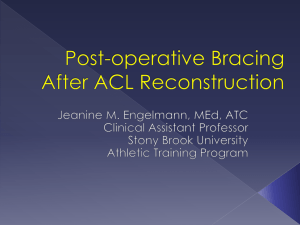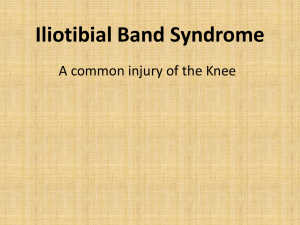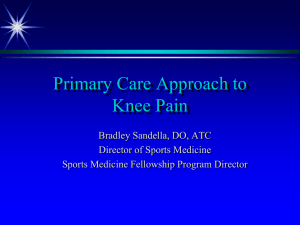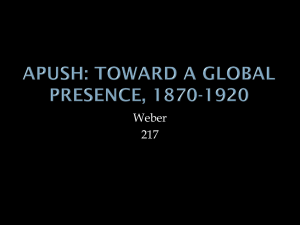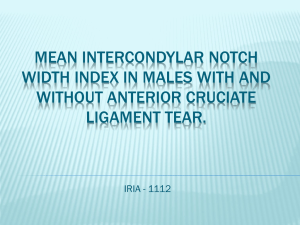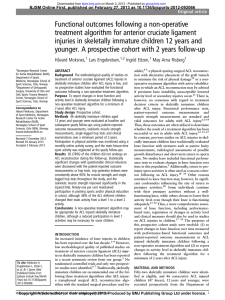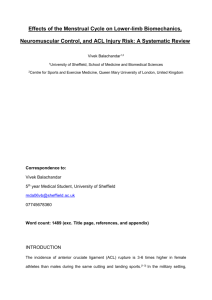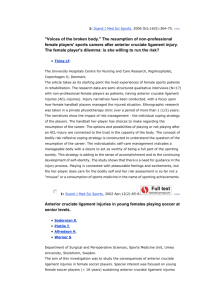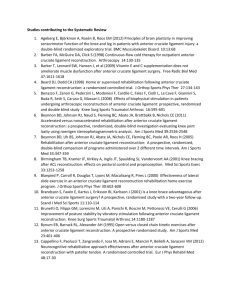Sports Physiotherapy - Department of Rehabilitation Sciences
advertisement
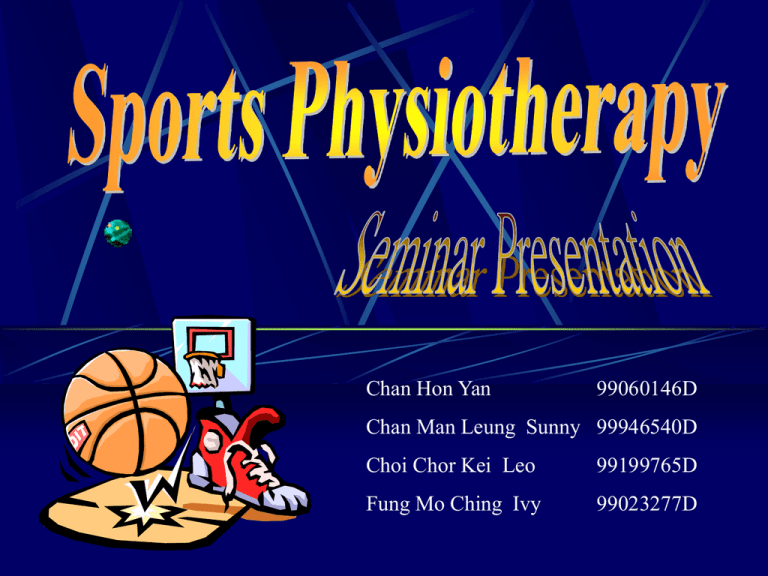
Chan Hon Yan 99060146D Chan Man Leung Sunny 99946540D Choi Chor Kei Leo 99199765D Fung Mo Ching Ivy 99023277D Topic 2 Mary, a 21 years old University student, belongs to Hong Kong Basketball Team. She twisted her (L) knee while landing from a rebound during competition 3 months ago. Her doctor informed her that she had suffered from a grade II ACL injury, and recommended Mary to have intensive rehabilitation with special emphasis on functional training. Outline of Presentation Gender Sports Skill Pathology Psychology Rehabilitation Program Return to Sports Introduction In a 5 year study, knee injuries accounted for 15% of total basketball injuries in National Collegiate Athletic Association (NCAA). Almost 20% of the knee structure injuries are ACL injury. The ACL injury rate in women was 4.1 times greater in basketball. (Arendt & Dick, 1995) Injury mechanism Non-contact planting & cutting straight-knee landing one-step landing with the knee hyperextended pivoting & sudden deceleration Effects on Structures after ACL injury Static stabilizer Medial menisci --- increase cross sectional area and volume, thickening at its attachment Posterior capsule --- thickening (Jackson et al., 1999) Decrease Bone Mineral Density (BMD) in the periarticular cancellous bone of femur and tibia (Boyd et al., 2000). Effects on Structures after ACL injury Dynamic stabilizer Hamstrings Quad Gastrocnemius Increase demand Non-copers vs Copers Non-copers had instability with activities of daily living . They stiffened their knees by landing in less flexion and accepting weight with less flexion in both walking and jogging. May lead to excessive joint contact forces which have potential to damage articular structure. (Rudloph et al., 1998) cannot return to previous performance Non-copers vs Copers Copers return to all pre-injury activity without limitation. Copers demonstrated increased hamstrings EMG, may be a compensation mechanism. (Tibone & Antich, 1993 and Boerboom et al., 2001) It has been suggested that Quadriceps and Gastrocnemius are also important for compensatory dynamic knee stabilization. (Nyland et al., 1997 and Kivist & Gillquist, 2001) Why are women more susceptible? Intrinsic factors (Huston LJ. et al, 2000) Q-angle femoral notch irreversible joint laxity hormonal influence - need more research to prove Why are women more susceptible? Extrinsic factors Proprioception muscle strength neuromuscular control knee stiffness Risk Factors Proprioception (Rozzi SL. et al, 1999) Female took longer than male to detect joint motion moving in the direction of knee joint extension May be less sensitive to potentially damaging force Increase risk for ligament injury Risk Factors Muscle strength (Huston LJ. & Wojtys EM. 1996) Female athletes has weaker knee extension & flexion strength than male Risk Factors Neuromuscular control Muscle recruitment pattern response to anterior tibial translation (Huston LJ. & Wojtys EM. 1996) Female athlete – quad-dominant Male athlete, men and female control subjects – hamstrings-dominant quad-dominate pattern: more strain on the ACL than cocontraction or contract the hamstrings first Risk Factors Knee stiffness Important component to knee stability and injury prevention Mm increase the joint contact force & decrease tibiofemoral displacement, dissipating potentially dangerous loads, lowering the force carried by the ACL and other passive structure Risk Factors Knee stiffness Valgus & Varus stiffness (Brant JT. & Cooke TD.,1988) knees in female rotate 66% more than males & 35% less stiff Ability to voluntarily stiffen the knee (Wojtys EM et al, 1999) Men: 4 times Women: 2 times Basic Skill in basketball Running Cutting Pivoting Rebounding Shooting (adapted from R J Emerson 1993) Running Change of speed and direction To get away from opponents To guard the route of offending opponent require slide-steps, backward steps Sudden deceleration & stopping prior to change of direction knee almost fully extended + twisted Cutting Use of technique such as fake, stops and pivot to get away from opponent Cutting method Side-step Cut Cross-over Cut Require sudden change of Speed Direction Pivoting Use of technique getting away from opponent by moving body and step one or more steps on one foot while keeping the other stationary Produce tibia torsion to knee Points to consider in return to sport Position Habits in performing skills Position Center Perform much pivoting under net for scoring Require more strength in jumping Many collision and body contact under net Need more proprioceptive training for balance during landing May consider any uses of brace to prevent re-injury Position Wing & Guard Perform many high speed cutting and shooting with 2-steps stop Perform much dribbling Abilities required: High power in initiating movement High agility with sudden change of cutting direction or pace need to stabilization of knee & agility Habit in Skills Kirkendall DT et al (2000) Cutting maneuver with less knee & hip flexion with knee valgus Higher injury rate of ACL training to perform cutting with knee flexion ACL injury reduced by 89% Psychological Support Explain to player nature and severity of the injury prognosis for recovery recommended courses of therapy estimate time frame of rehabilitation Reassurance and support Peer support Visual-Motor Behaviour Rehearsal (VMBR) Rehearse an entire performance e.g. Landing with proper foot placement Review and correct a specific performance e.g. Remind herself the wrong habit in sport Practice approaching the crowd or competition with confidence Goals of rehabilitation Gender aspect: To minimize possible risk factors for recurrence of ACL injury in female basketball player Sports aspect: To restore physical capacity in competing in basketball games Psychological aspect: To overcome fear associated with the injury movement Functional Training Perturbation training Plyometric training Agility training Sport-specific training Perturbation Training Techniques involving perturbation of support surfaces roller board tilt board roller board & stationary platform Induce compensatory muscle activity Advantages of Perturbation Training Fitzgerald et al., 2000: Enhance the probability of successful return to high-level physical activity perturbation group with greater long-term success Improve knee stability reduce the risk of continued episodes of giving way of knee during athletic participation Plyometric Training Neuromuscular training Develop power, strength & coordination involve a prestretching of muscle induce the stretch-shortening cycles Plyometric Training Goal: Decrease reaction time between eccentric lengthening of mm and concentric mm contraction Increase power Advantages of Plyometric training Hewett et al, 1996 &1999: Decrease landing forces Increase vertical jump height Improve knee stabilization Improve hamstring-to-quadriceps strength ratio Decrease incidence of knee injury in female athletes Examples of Plyometric Training Hewett et al, 1996 &1999: Cone jump Jump, jump, jump, vertical Agility Training Allow pt to adapt to: quick changes in direction quick starting and stopping cutting & pivoting improve proprioception Agility training significantly improves mm reaction time in response to anterior tibial translation (Wojtys et al, 1996) Figure-of-eight Drills gradual change of direction allow adaptation to cutting activity Longer distances shorter distances (smaller surface area tighter “8” ) backward “8” Cutting Maneuver Drills Sidestep cut Crossover cut half-speed full-speed 45o 60o 90o cutting Carioca Shuttle Run Involve straight plane running, acceleration, deceleration, cutting & pivoting •SEMO drill Others •incorporate forward, backward, diagonal acceleration and lateral movt Start Sport Specific Training Start when full speed agility training was achieved sport specific tasks are added during the agility training For basketball player: Dribbling skills Ball catching Ball passing Sport Specific Training Started w/o being opposed Progressed to one-on-one opposition Progressed to real competition Question & Answer Session References Arendt E. Dick R. Knee injury patterns among men and women in collegiate basketball and soccer. NCAA data and review of literature. American Journal of Sports Medicine. 23(6):694-701, 1995 Baratta R. Solomonow M. Zhou BH. Letson D. Chuinard R. D'Ambrosia R. Muscular coactivation. The role of the antagonist musculature in maintaining knee stability. American Journal of Sports Medicine. 16(2):113-22, 1988. Boden BP. Dean GS. Feagin JA Jr. Garrett WE Jr. Mechanisms of anterior cruciate ligament injury. Orthopedics. 23(6):573-8, 2000 Boerboom AL. Hof AL. Halbertsma JP. van Raaij JJ. Schenk W. Diercks RL. van Horn JR. Atypical hamstrings electromyographic activity as a compensatory mechanism in anterior cruciate ligament deficiency. Knee Surgery, Sports Traumatology, Arthroscopy.9(4):211-6, 2001 Boyd SK. Matyas JR. Wohl GR. Kantzas A. Zernicke RF. Early regional adaptation of periarticular bone mineral density after anterior cruciate ligament injury. Journal of Applied Physiology. 89(6):2359-64, 2000 Bryant JT. Cooke TD. Standardized biomechanical measurement for varusvalgus stiffness and rotation in normal knees. Journal of Orthopaedic Research. 6(6):863-70, 1988. Colby S. Francisco A. Yu B. Kirkendall D. Finch M. Garrett W Jr. Electromyographic and kinematic analysis of cutting maneuvers. Implications for anterior cruciate ligament injury. American Journal of Sports Medicine. 28(2):234-40, 2000 Fitzgerald GK. Axe MJ. Snyder-Mackler L. Proposed practice guidelines for nonoperative anterior cruciate ligament rehabilitation of physically active individuals. Journal of Orthopaedic & Sports Physical Therapy. 30(4):194-203, 2000 Fitzgerald GK. Axe MJ. Snyder-Mackler L. The efficacy of perturbation training in nonoperative anterior cruciate ligament rehabilitation programs for physical active individuals. Physical Therapy. 80(2):128-40, 2000 Huston LJ. Greenfield ML. Wojtys EM. Anterior cruciate ligament injuries in the female athlete. Potential risk factors. Clinical Orthopaedics & Related Research. (372):50-63, 2000. Huston LJ. Wojtys EM. Neuromuscular performance characteristics in elite female athletes. American Journal of Sports Medicine. 24(4):427-36, 1996 Hewett TE. Lindenfeld TN. Riccobene JV. Noyes FR. The effect of neuromuscular training on the incidence of knee injury in female athletes. A prospective study. American Journal of Sports Medicine. 27(6):699-706, 1999 Hewett TE. Stroupe AL. Nance TA. Noyes FR. Plyometric training in female athletes. Decreased impact forces and increased hamstring torques. American Journal of Sports Medicine. 24(6):765-73, 1996 Kirkendall DT. Garrett WE Jr. The anterior cruciate ligament enigma. Injury mechanisms and prevention. Clinical Orthopaedics & Related Research. (372):64-8, 2000 Jackson DW. Schreck P. Jacobson S. Simon TM. Reduced anterior tibial translation associated with adaptive changes in the anterior cruciate ligamentdeficient joint: goat model. Journal of Orthopaedic Research.17(6):810-6, 1999 Kvist J. Gillquist J. Anterior positioning of tibia during motion after anterior cruciate ligament injury. Medicine & Science in Sports & Exercise. 33(7):106372, 2001. Kvist J. Gillquist J. Sagittal plane knee translation and electromyographic activity during closed and open kinetic chain exercises in anterior cruciate ligament-deficient patients and control subjects. American Journal of Sports Medicine. 29(1):72-82, 2001 MacWilliams BA, Wilson DR, DesJardins JD, Romero J, Chao EYS. Hamstring cocontraction reduces internal rotation anterior translation, and anterior cruciate ligament load in weight-bearing flexion. Journal of Orthopaedic Research. 17(6):817-822,1999. Rozzi SL. Lephart SM. Gear WS. Fu FH. Knee joint laxity and neuromuscular characteristics of male and female soccer and basketball players. American Journal of Sports Medicine. 27(3):312-9, 1999. Rudolph KS. Eastlack ME. Axe MJ. Snyder-Mackler L. 1998 Basmajian Student Award Paper: Movement patterns after anterior cruciate ligament injury: a comparison of patients who compensate well for the injury and those who require operative stabilization. Journal of Electromyography & Kinesiology. 8(6):349-62, 1998 Rudolph KS. Axe MJ. Buchanan TS. Scholz JP. Snyder-Mackler L. Dynamic stability in the anterior cruciate ligament deficient knee. Knee Surgery, Sports Traumatology, Arthroscopy. 9(2):62-71, 2001 Tibone JE. Antich TJ. Electromyographic analysis of the anterior cruciate ligament-deficient knee. Clinical Orthopaedics & Related Research. (288):359, 1993 Wojtys EM. Huston LJ. Taylor PD. Bastian SD. Neuromuscular adaptations in isokinetic, isotonic, and agility training programs. American Journal of Sports Medicine. 24(2):187-92, 1996
